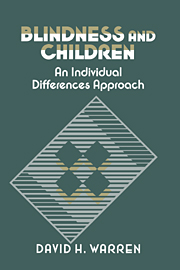13 - Individual differences
from Part IV - Summary
Published online by Cambridge University Press: 02 December 2009
Summary
In the introduction to this book, I offered several reasons for my conviction that a differential approach to research on visual impairment in children is more suitable than the more traditional comparative approach. There are excellent examples of differential research, and these have been noted. Much of the existing research, however, has used the comparative model, and therefore it is difficult to interpret the impact of this work within a differential framework. Use of the comparative model usually means that investigation and explanation of individual differences within the sample of children with visual impairments is not a high priority in the design, analysis, or reporting of the results. Often such information is hidden within the analyses and therefore completely irretrievable, but sometimes it is possible to glean bits of information about how children's characteristics vary as a result of their age or visual status, or of features of their environments. I have searched for and reported such instances as thoroughly as possible. I have summarized the main features of these outcomes in the course of each chapter, and a detailed review is unnecessary here.
It may, however, be useful to consider these variables in broad overview. We will begin with status variables and then move to factors that vary within the child's environment.
Status variables
Status variables are characteristics related to the condition of visual impairment. They have in common that they are not amenable to intervention. That is, we have no control over the age at which the child loses vision, the severity of the visual loss, the cause of the visual loss, or the presence or absence of additional handicapping conditions.
- Type
- Chapter
- Information
- Blindness and ChildrenAn Individual Differences Approach, pp. 318 - 332Publisher: Cambridge University PressPrint publication year: 1994



